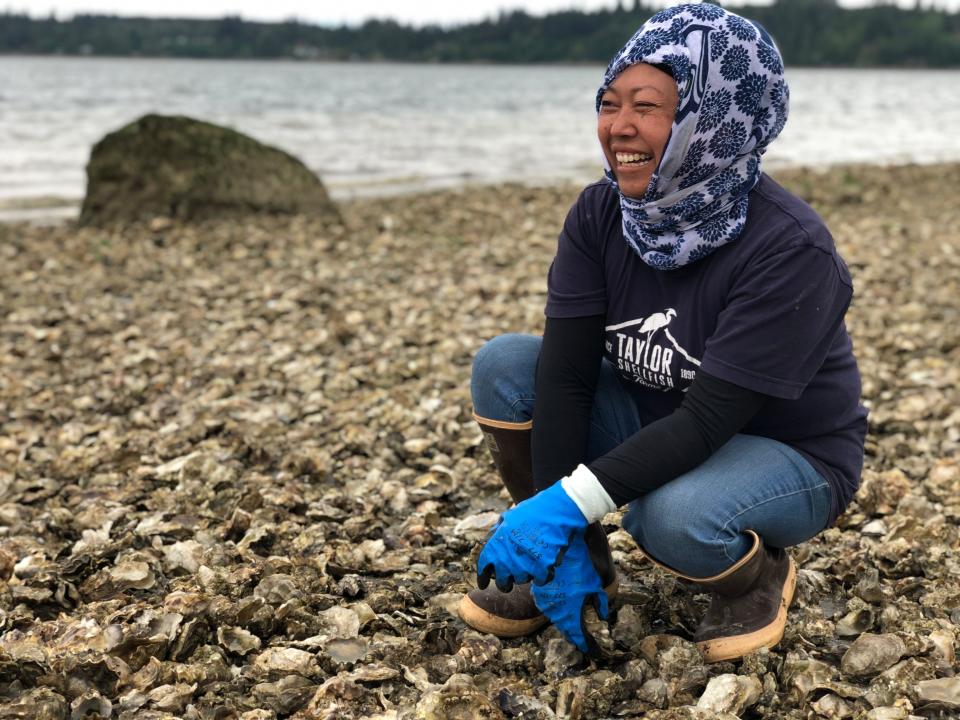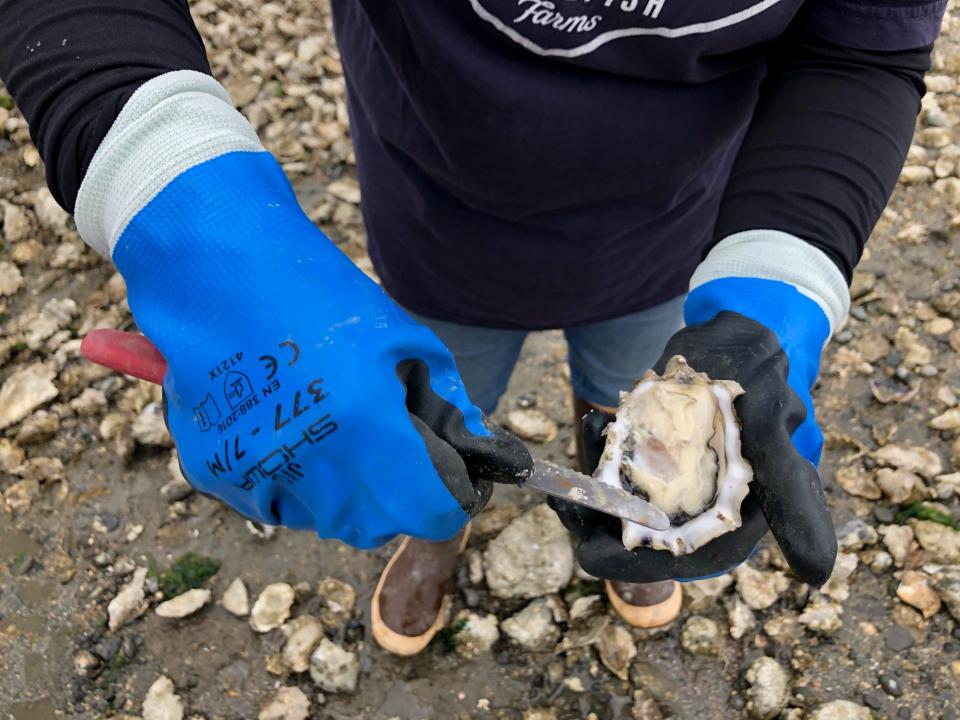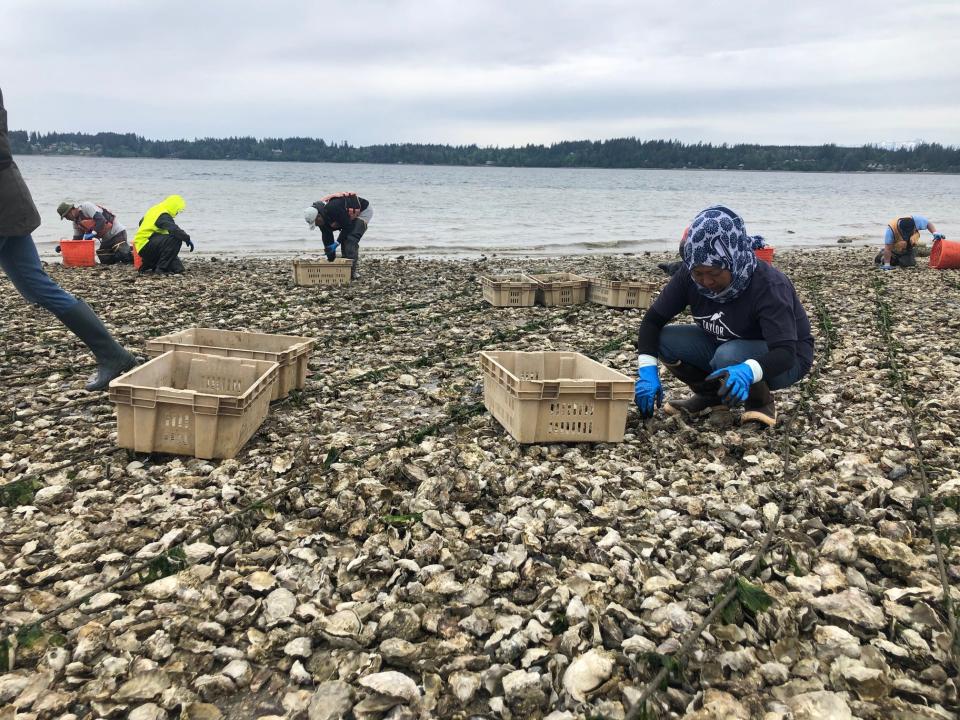A farmer plucking oysters from a crowded beach plays a needed role during the coronavirus pandemic
OLYMPIA, Wash. – Aisha Prohim walked through the aisles of her local Asian supermarket an hour south of Seattle in early March and took note of the empty freezers and bare aisles. Coolers typically stuffed with yellow catfish and tilapia stood unfilled, and shelves were missing the usual piles of rice.
Prohim did some mental math. Our food is going to get so expensive, she thought anxiously. I have to go back to work – soon.
She needed money – to save in an emergency fund, to buy extra food. Unemployment checks would last only so long. Her husband enjoyed fixing cars on the side, a sometimes pricey hobby. “No more!" she told him sternly one night, insisting they cut unnecessary expenses. She worried for her three children, particularly her ability to pay for their college educations should they wish it.
She worried, too, for the millions of Americans who rely on her work to keep from going hungry, particularly in Chinese and Japanese communities, where shellfish is often a main ingredient.
Prohim, who has spent the past 12 years as an oyster farmer, felt the impact of coronavirus before most. Her employer, Taylor Shellfish, typically sells about $1.3 million worth of product a weekwith 30% of that shipping to Asia.
But as China’s economy sputtered amid the outbreak in early 2020 and travel bans dramatically slowed freight shipments, Taylor Shellfish – which started in 1890 and employed 730 people before the coronavirus – laid off 50 people in early February. Prohim, 49, lasted until the beginning of March, when 500 more were laid off.
Six weeks later she was back to work, after Taylor Shellfish got money from the Paycheck Protection Program, the federal loan program that is helping small businesses stay afloat and hire workers back amid the economic crisis.
Crunch! Ding! Click!
By mid-May, Prohim squats on the eastern shore of the Totten Inlet, a beach littered with shellfish, tossing only the best oysters – she looks for thick, deep shells, which translates to a meatier oyster – into her basket.
She takes a step on the crowded beach. Crunch! She swipes up two oysters, knocking them together as she examines them. Ding! She tosses one into her basket, where it knocks against the side. Click!
She works quickly, the tide lapping at her feet, the wind cutting across her face, doing her part to keep America fed.
As residents all over the country stayed safe inside their homes, leery of catching the virus that has killed 100,000 in the U.S. alone, millions of workers like Prohim went to work to keep the nation’s food chain churning. That she and others who look like her – studies have shown the majority of essential workers are women of color – are risking their health for a country run by a president who opponents say isn’t welcoming of them doesn't sit well with Prohim.

“It frustrates me,” Prohim says. “All I hear on TV is ‘Let’s make America great again.’ They don’t want us – people with brown skin – they don’t want us here. But we’re the ones doing the dirty work. They don’t want to do this.”
She gestures around her to the thousands of oysters – Taylor Shellfish operates 15,000 acres of tidelands, growing 426,000 shellfish an acre – that need harvesting.
Crunch! Ding! Click!
Around her, a dozen farmers squat and bend over, shoveling oysters into buckets before the tide creeps back in and their workspace disappears.
Farming shellfish is punishing, physical work. Workers’ days are dictated by the tide: They must harvest during the lowest points, which comes in the middle of the night during frigid winters, and the middle day during scorching, humid summers. They work seven to 10 days in a row, then take a couple of days off. Prohim, a farm manager who overseas 15 employees, jokes that shellfish farmers are "the ocean postmen": Neither rain, nor sleet, nor dark of night keeps them from their jobs.
And their work is essential, she says, not just for right now but the future, as oyster farmers plan eight to 10 years in advance. Abandoning their farms altogether would have been devastating for the company financially and for the food chain as a whole. If farmers ignore oysters, they grow long and lean, like a bananas. No one wants to buy banana-shaped oysters.
“People think of farming and they think of agriculture; they don’t think of shellfish farming,” Prohim says. “But you have to plan, harvest and sell no matter what type of farmer you are. It takes so much TLC and planning before that product is all the way to your table.”
Shellfish, and oysters in particular, might strike some as food for fancy rich people, evoking visions European getaways and tall glasses of champagne. But eating shellfish has become more common in the U.S., especially as Americans consume less meat and more seafood in an effort to reduce their carbon footprint.
What’s more, with more Americans cooking at home as restaurants closed, retail sales for seafood have hit record highs. Before the pandemic, direct-to-consumer sales accounted for 1% of Taylor Shellfish’s sales. But e-commerce has exploded in the wake of the coronavirus, now totaling 10% of all sales, according to marketing director Marcelle Taylor Gonzalez.
“You’d be surprised how much seafood has worked its way into the American diet,” Taylor Gonzalez says. “There’s a big part of the U.S. that depends on seafood for their protein, and we have to continue to provide for them.”

Child of a rice field worker, daughter of ‘King Clam Digger’
Prohim plays an integral part in doing just that.
Four decades ago, her family fled war-torn Cambodia, hopscotching across Southeast Asia before landing in Philadelphia in December 1980. Prohim was 8 and spoke no English. Neither did her parents.
Like so many others, they came to America seeking safety and financial stability. They found it in farming, which Prohim says it was “in our DNA.” Back in Cambodia, her mother worked in rice fields. Before Prohim joined Taylor Shellfish, her father spent 28 years there and was nicknamed the "King Clam Digger." (Her husband, Saleh, a farm director who hired her in 2008, is known as the "Prince Clam Digger.")
Prohim understands she doesn't fit the image of a stereotypical farmer, with her petite, 4-foot-11 frame, a Seattle Seahawks scarf serving as a makeshift hijab and her quick smile. When she started oyster farming in 2008, after five years as a mushroom farmer, no one thought she’d last long.
One of her first nights on the beach in 2008, snow covered the ground and temperatures plunged into the high 20s. Ice slivers stuck to her gloves and her toes went numb as she shoveled 300 oysters into a tub, working with a partner to fill three tubs.
Crunch! Ding! Click!

She shivered, and smiled.
“I like this!” she kept thinking. “I like being outdoors!”
The crew started taking bets. She’d last a week, the crew master wagered. Give her a month, said a few other farmers.
Twelve years later “I’m still here, and the crew master is gone,” Prohim says with a sly smile. Now, she can fill six tubs a day on her own.
Though she hasn’t personally experienced any xenophobia tied to the coronavirus outbreak, anecdotes about that from others in the Asian community infuriate her. She knows what it’s like to be picked on for looking different: Three years ago, on her way to the beach, a homeowner stuck her head outside her door and gave Prohim and her Islamic hijab a dirty look.
“Why do you wear that rag on your head?” she sneered at Prohim, who ignored the comment and kept walking.
A couple of days later, the homeowner got bolder.
“Why do you guys kill people?” the person said.
Prohim declined to engage.
SUBSCRIBE: Help support quality journalism like this.
Skepticism and success
Her life's theme has been one of succeeding despite skepticism.
When playing high school basketball wasn’t realistic because young Muslim girls covering every inch of skin and participating in sports was unheard of in Texas in the 1980s, she fell in love with camping and other outdoor activities, refusing to acknowledge any heartbreak for the rejection of her faith.
In high school, she pushed herself to graduate with honors, despite English being a second language and attending three schools in four years.
As a farmer, she has excelled even though co-workers openly doubted her, anxious to prove that farming can be women’s work, too. And now she’s pushing herself past her own limitations, eager to do her part to keep America running.
Her work keeps her lean and cut, with bulging forearms. But it comes at a cost: She’s regularly bothered by nagging tendinitis in her right elbow. When it flares up, she rubs IcyHot on it and takes breaks. She has no plans to ask for a desk job.

Her childhood in Cambodia comes to her in fragments, pieces of a puzzle she tries to fit together to remember life in another country: racing up the country’s mountainside with friends, breathless at the top but so happy to be playing outside … a chronically sick little brother who died before they could leave the country, her mother wrapping his body and walking dozens of miles to the next town where her uncle helped give him a proper Muslim burial … pressing her ear up to the door of her parents’ bedroom, where they recited the A-B-Cs in preparation for moving to America.
“My mom never wanted to talk about it,” she recalls. “We lost a lot of family during the war. In those days, even a family member would stab you in the back – literally – to survive.”
Knowing her parents scarified so much, Prohim is determined to do the same for her three children, ages 13-24. When the virus hit and the economy cratered, she reverted to her childhood and started saving money. Immigrants, she says, are always “ready for the unexpected.” And if her children want to go to college, she plans to be able to provide that avenue to them.
SUBSCRIBE: Help support quality journalism like this.
Right now, her boys, Ammar, 24, and Zaki, 19, both work at the farm with Prohim and her husband. Going back to work felt reasonably low-risk, because in addition to being outside, the entire family is exposed to the same germs, save for 13-year-old daughter Hanna, who Prohim jokes “we never see anyway, because she’s always in her room by herself – she’s a teenager, it’s what they do.” All their gear and equipment stays in the car, away from Hanna. The entire family is zealous in their hand-washing.
None of Taylor Shellfish employees have tested positive for the coronavirus, despite being just 70 miles south of the early U.S. outbreak in Kirkland, Washington. In mid-May, the company was down to a skeleton crew in their processing plants, strictly enforcing the recommended social distancing.
Outside, Prohim stresses that it’s easy to keep a safe distance from others on a miles-long beach. Plus, she says, they have to work. They have to keep the country fed.
It’s good work for good money, Prohim explains, and you see the results instantly. In Southeast Asia, you can “work all day in the rice fields and only make $1. Here, you can make money to survive here, and send money back home.”
Crunch! Ding! Click!
America’s Food Chain: Who feeds the nation during the COVID-19 pandemic?
As many of us across America have hunkered down in our homes under safer-at-home orders, someone else has had to venture out day after day to keep the country fed.
To get the food from the farm to our tables, they continue to work – sometimes without the protections we’re told are crucial to guard against the coronavirus – to pick the oranges, slaughter the pigs, truck the goods and cook the food, so America can continue to eat.
Through an occasional series of intimate portraits in the coming weeks, USA TODAY Network journalists are shining a light on their lives and work.
This article originally appeared on USA TODAY: Amid COVID-19 pandemic, an oyster farmer's work became essential

